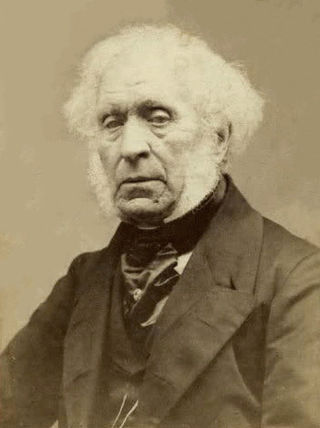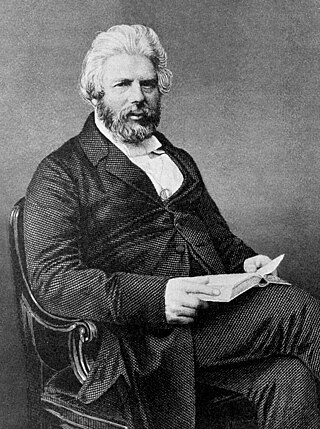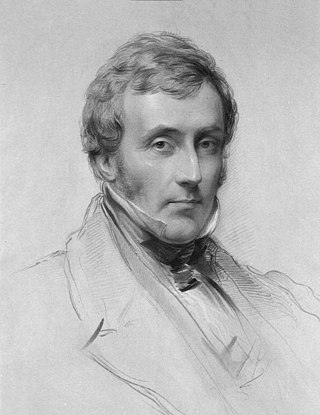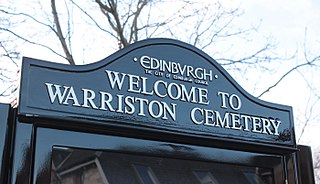
Thomas Jameson Torrie FRSE (died 7 August 1858) was a Scottish advocate, geologist, botanist and author. He was a competent artist and made his own botanical drawings.

Thomas Jameson Torrie FRSE (died 7 August 1858) was a Scottish advocate, geologist, botanist and author. He was a competent artist and made his own botanical drawings.
Torrie was the son of Patrick Torrie (1763–1810) and Janet Jameson (1776–1853), the sister of Robert Jameson, who was a strong influence upon him.
He trained as a lawyer at the University of Edinburgh, and qualified as an advocate in 1830. However his primary interests lay in scientific investigations. In 1827 he was President of Edinburgh's Plinian Society, a group of like-minded thinkers and scientists. In 1832 he inherited £10,000, a large sum for the day, enabling him to pursue his scientific interests at leisure. [1]
He was elected a Fellow of the Royal Society of Edinburgh in 1834, his proposer was Sir John Robison. [2] At this time he was living in an imposing Georgian townhouse at 21 Royal Circus in Edinburgh's New Town. [3] He also served on the Committee of the British Association for the Advancement of Science. [4]
He visited Mount Vesuvius during an eruption, and reported his observations back to several scientific bodies. [5]
He died in Roslin in Midlothian on 7 August 1858, [6] and is buried in Warriston Cemetery.
He married Catherine Paton (1820–1867) in 1846. They had 3 sons and a daughter; Janet Torrie, Robert Torrie, Lawrence Jameson Torrie (born 1852) and Thomas Torrie, the Scotland international rugby union player. [7]

Sir David BrewsterKH PRSE FRS FSA Scot FSSA MICE was a Scottish scientist, inventor, author, and academic administrator. In science he is principally remembered for his experimental work in physical optics, mostly concerned with the study of the polarization of light and including the discovery of Brewster's angle. He studied the birefringence of crystals under compression and discovered photoelasticity, thereby creating the field of optical mineralogy. For this work, William Whewell dubbed him the "father of modern experimental optics" and "the Johannes Kepler of optics."

Robert Chambers was a Scottish publisher, geologist, evolutionary thinker, author and journal editor who, like his elder brother and business partner William Chambers, was highly influential in mid-19th-century scientific and political circles.

Francis Jeffrey, Lord Jeffrey was a Scottish judge and literary critic.
The British Science Association (BSA) is a charity and learned society founded in 1831 to aid in the promotion and development of science. Until 2009 it was known as the British Association for the Advancement of Science (BA). The current Chief Executive is Katherine Mathieson. The BSA's mission is to get more people engaged in the field of science by coordinating, delivering, and overseeing different projects that are suited to achieve these goals. The BSA "envisions a society in which a diverse group of people can learn and apply the sciences in which they learn." and is managed by a professional staff located at their Head Office in the Wellcome Wolfson Building. The BSA offers a wide variety of activities and events that both recognize and encourage people to be involved in science. These include the British Science Festival, British Science Week, the CREST Awards, Huxley Summit, Media Fellowships Scheme, along with regional and local events.

Robert Jameson FRS FRSE was a Scottish naturalist and mineralogist.

Patrick Fraser Tytler FRSE FSA(Scot) was a Scottish advocate and historian. He was described as the "Episcopalian historian of a Presbyterian country".

William Pulteney AlisonFRSE FRCPE FSA was a Scottish physician, social reformer and philanthropist. He was a distinguished professor of medicine at the University of Edinburgh. He served as president of the Medico-Chirurgical Society of Edinburgh (1833), president of the Royal College of Physicians of Edinburgh (1836–38), and vice-president of the British Medical Association, convening its meeting in Edinburgh in 1858.
James Moncreiff, 1st Baron Moncreiff of Tullibole LLD was a Scottish lawyer and politician.

The Right Honourable Alexander Maconochie, Lord Meadowbank of Garvock and Pitliver, was a Scottish advocate, judge, landowner and politician. After 1854 he took the surname Maconochie-Welwood.

Charles Neaves, Lord Neaves FRSE was a Scottish advocate, judge, theologian and writer. He served as Solicitor General (1852), as a judge of the Court of Session, the supreme court of Scotland (1854), and as Rector of the University of St Andrews (1872).

Sir George Deas, Lord Deas (1804–1887) was a 19th century Scottish judge.

William Gregory FRCPE FRSE FCS was a Scottish physician and chemist. He studied under and translated some of the works of Justus von Liebig, the German chemist. Gregory also had interests in mesmerism and phrenology.

Warriston Cemetery is a cemetery in Edinburgh. It lies in Warriston, one of the northern suburbs of Edinburgh, Scotland. It was built by the then newly-formed Edinburgh Cemetery Company, and occupies around 14 acres (5.7 ha) of land on a slightly sloping site. It contains many tens of thousands of graves, including notable Victorian and Edwardian figures, the most eminent being the physician Sir James Young Simpson.

Thomas ThomsonFRSE FSA Scot was a Scottish advocate, antiquarian and archivist who served as Principal Clerk of Session (1828–1852) and as secretary of the literary section of the Royal Society of Edinburgh (1812–20).
Thomas Morton was a Scottish shipwright and inventor. His most widely known invention is the patent slip.

John Clerk of Middlebie (1790–1856) was a Scottish advocate and father of the mathematical physicist James Clerk Maxwell.

Alexander Black was a Scottish architect, born in Edinburgh around 1790 who is mainly known for his association with George Heriot’s School, where he acted as Superintendent of Works for most of his active life.

Scottish education in the nineteenth century concerns all forms of education, including schools, universities and informal instruction, in Scotland in the nineteenth century. By the late seventeenth century there was a largely complete system of parish schools, but it was undermined by the Industrial Revolution and rapid urbanisation. The Church of Scotland, the Free Church of Scotland and the Catholic church embarked on programmes of school building to fill in the gaps in provision, creating a fragmented system. Attempts to supplement the parish system included Sunday schools, mission schools, ragged schools, Bible societies and improvement classes. Scots played a major part in the development of teacher education with figures including William Watson, Thomas Guthrie, Andrew Bell, John Wood and David Stow. Scottish schoolmasters gained a reputation for strictness and frequent use of the tawse. The perceived problems and fragmentation of the Scottish school system led to a process of secularisation, as the state took increasing control. The Education (Scotland) Act 1872 transferred the Kirk and Free Kirk schools to regional School Boards and made some provision for secondary education. In 1890 school fees were abolished, creating a state-funded, national system of compulsory free basic education with common examinations.

John Croumbie Brown was a prolific author, minister of religion, forestry pioneer in South Africa as well as soil conservationist and hydrologist. He was the grandson of John Brown (1722-1787), the renowned Scottish theologian and author.
Thomas Torrie was a Scotland international rugby union player.
{{cite web}}: CS1 maint: archived copy as title (link)